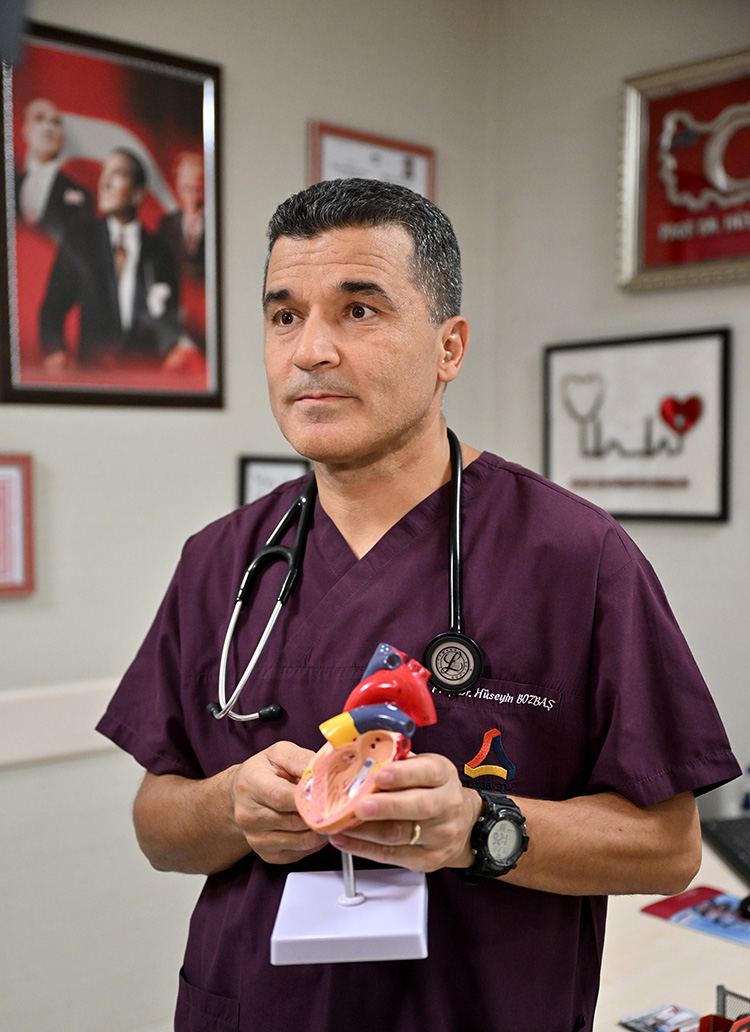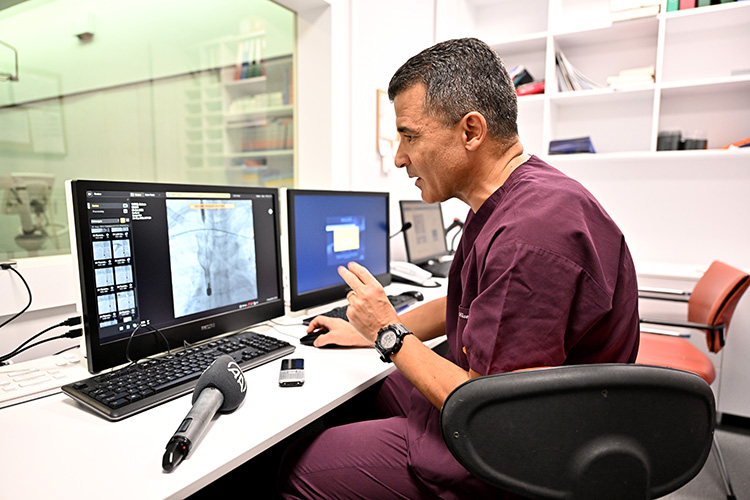Advanced insufficiency in the right heart valve, for which there is no surgical chance, can be addressed by entering through the groin vessel using an angiographic method, and reducing the risk of enlargement in the heart by implanting a new biological valve.
Prof. Dr. Hüseyin Bozbaş, a faculty member in the Department of Cardiology at the Turkey Chambers and Stock Exchanges Union (TOBB) Faculty of Medicine Hospital, stated that heart and vascular diseases rank first among causes of death worldwide.
Bozbaş explained that conditions such as vascular stiffness, heart failure, and valve insufficiencies constitute the causes of death related to cardiovascular diseases, emphasizing that the risk of death increases with age.
Highlighting that the leakage of blood backward from the right heart valve (tricuspid insufficiency) has become an increasing health problem in recent years, Bozbaş stated, “Right valve insufficiency is defined as the backward escape of blood that should go forward to the lungs.”

Bozbaş, explaining that heart valves are flexible structures that allow the passage of blood, continued his words as follows:
“Heart valves, which enable the one-way flow of blood, open during the passage of blood and then close again. When this closure is not complete, blood escapes backward. In other words, insufficiency occurs in the valve.
As the disease progresses, there is enlargement on the right side of the heart, and blood pressure increases in the pulmonary vessels. This condition leads to complaints such as shortness of breath, swelling in the legs, and accumulation of fluid in the abdominal cavity in patients. Over time, the heart enlarges further, weakens, and the risk of death increases.”

Bozbaş emphasized that in Turkey, this method has been successfully applied to 5 patients. He stated that drug therapy is not curative in heart valve insufficiency; it only alleviates symptoms. Bozbaş noted that intervention on the valve is essential for curative treatment.
Explaining the available methods for this intervention, Bozbaş mentioned that it can be done by surgically repairing or replacing the valve, or by using angiography to repair or implant a new valve. He said, “Previously, in this group of patients, the risk of surgery was very high, leaving them almost helpless. However, with the advancements in modern medicine today, there are treatment options available through angiographic methods. With angiography, a new biological valve can be placed or the valve can be repaired by entering the patient’s groin artery.”
Bozbaş highlighted that the method of placing a biological valve through angiography is a recently implemented technique worldwide, yielding successful results. He concluded by stating, “In Turkey, this method has been successfully applied to 5 patients.”

Bozbaş explained that this new method is applied to patients with right heart valve insufficiency who, due to the high risk of death, do not have the chance for surgery. He provided the following details about the procedure:
“The procedure is performed without general anesthesia, with the patient in a semi-conscious state and without being connected to a breathing apparatus. A small 8-9 millimeter vessel route is opened from the right groin vein, and a special biological valve system is placed into the upper and lower main veins of the heart using a special wire. By placing a two-part structure, the backflow of blood from the right valve is prevented. Thus, the blood cannot come up or go down. Consequently, after the procedure, swelling in the patient’s legs and abdominal cavity decreases, walking capacity improves, and shortness of breath diminishes. The risk of enlargement in the heart is reduced after the application.
There is no open surgery or any incision made for the patient. The procedure takes about 1 hour, and the patient is discharged within 3-5 days, depending on their health condition. The application is performed on patients with a significant leakage in the right valve of the heart and a high risk of surgery.”
Prof. Dr. Bozbaş emphasized the significant advantages of the new application for the patient. He stated that in traditional surgery, the patient stays in the hospital for a much longer period, while with the angiographic method, a very short intensive care follow-up is conducted. Bozbaş mentioned, “The procedure performed through the vessel route from the groin is a sutureless process. The patient does not receive general anesthesia and is not connected to a breathing apparatus. There is no need for blood transfusion. Since the patient stays in the hospital for a very short time, the risk of infection is also greatly reduced.”

Bozbaş provided information about the procedure performed on Gülsen Yapıcı, a 71-year-old patient with right heart valve insufficiency using the angiographic method, for her second birthday celebration:
“For our patient Gülsen Yapıcı, who had a severe insufficiency in the right valve of her heart, and was experiencing fluid accumulation in the abdominal cavity, swelling in the legs, and shortness of breath, indicative of advanced-stage right heart failure, we decided to implant a valve using the angiographic method due to the high risk of surgery. The procedure was successful, and she is currently improving. In the coming days, our patient will be even better.”

Gülsen Yapıcı, expressing her feelings, stated that this was like a second birth for her: “I am very happy; I’ve been saved. I have many dreams. One of them is to go out to eat with my grandchildren. I will take a walk in the park with my husband. We will cut a cake for my second birthday celebration.”
Osman Yapıcı, Gülsen Yapıcı’s husband, shared their joy upon learning about this method when there was no chance of surgery for his wife: “We have been married for about fifty-one years. She is my wife, my everything. No amount of prayers can be enough. When we leave here, I will take my wife wherever she wants to go.”

